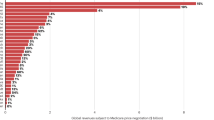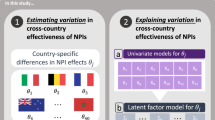Abstract
The pharmaceutical industry faces considerable challenges, both politically and fiscally. Politically, governments around the world are trying to contain costs and, as health care budgets constitute a very significant part of governmental spending, these costs are the subject of intense scrutiny. In the United States, drug costs are also the subject of intense political discourse. This article deals with the fiscal pressures that face the industry from the perspective of R&D. What impinges on productivity? How can we improve current reduced R&D productivity?
This is a preview of subscription content, access via your institution
Access options
Subscribe to this journal
Receive 12 print issues and online access
$209.00 per year
only $17.42 per issue
Buy this article
- Purchase on Springer Link
- Instant access to full article PDF
Prices may be subject to local taxes which are calculated during checkout



Similar content being viewed by others
References
Kola, I. & Rafferty, M. New technologies that may impact drug discovery in the 5–10 year timeframe workshop. 2002 Biomed. Expo Ann Arbor Michigan (data derived from Prous Science, Drugs News Prospect (2002).
Franz, S. 2003 approvals: a year of innovation and upward trends. Nature Rev. Drug Discov. 3, 103–105 (2004).
Accenture Consulting. High performance drug discovery: an operating model for a new era. Accenture (2001).
DiMasi, J. A., Hansen, R. W. & Grabowski, H. G. The price of innovation: new estimates of drug development costs. J. Health Econ. 22, 151–185 (2003).
Fearn, C. J. IMS Health. The World Pharmaceutical Market Presented at the Strategic Management Review, Australia, 19–20 June (2002).
Booth, B., Glassman, R. & Ma, P. Oncology's trials. Nature Rev. Drug Discov. 2, 609–610 (2003).
Benjamin, G. A. & Lumley, C. E. Industry Success Rates 2003 Including Trends in Success Rates CMR Report Number 03–202 R (CMR International Surrey, UK, 2003).
Van den Haak, M. A., Palachandran, J. & Benjamin, G. A. Performance Metrics in Global Pharmaceutical R&D, Company specific review 2002 for Merck & Co. (CMR International, Surrey, UK, 2003).
Roberds, S. L. et al. BACE knockout mice are healthy despite lacking the primary β-secretase activity in brain: implications for Alzheimer's disease therapeutics. Hum. Mol. Genet. 10, 1317–1324 (2001).
Gowen, et al. Cathepsin K knockout mice develop osteopetrosis due to a deficit in matrix degradation but not demineralization. J. Bone Miner. Res. 14, 1654–1663 (1999).
Lazner, F., Gowen, M. & Kola, I. An animal model for pycnodysostosis: the role of cathepsin K in bone remodeling. Mol. Med. Today 5, 413–414 (1999).
Ma, P. & Zemmel, R. Value of novelty? Nature Rev. Drug Discov. 1, 571–572 (2002).
Acknowledgements
We wish to acknowledge Datamonitor for the assembly of data (Pharmaceutical R&D Benchmarking Forum) used in this study.
Author information
Authors and Affiliations
Corresponding author
Ethics declarations
Competing interests
I.K. is an employee of Merck & Co., Inc., and has financial interests in Merck, Pfizer Inc. and Schering-Plough Corp. J.L. is an employee of Schering-Plough Corp. and has financial interests in Schering-Plough and Pfizer Inc.
Related links
Rights and permissions
About this article
Cite this article
Kola, I., Landis, J. Can the pharmaceutical industry reduce attrition rates?. Nat Rev Drug Discov 3, 711–716 (2004). https://doi.org/10.1038/nrd1470
Issue Date:
DOI: https://doi.org/10.1038/nrd1470
This article is cited by
-
Will we ever be able to accurately predict solubility?
Scientific Data (2024)
-
Zonisamide attenuates pressure overload-induced myocardial hypertrophy in mice through proteasome inhibition
Acta Pharmacologica Sinica (2024)
-
Single-cell mapping of lipid metabolites using an infrared probe in human-derived model systems
Nature Communications (2024)
-
Model-based assessment of combination therapies – ranking of radiosensitizing agents in oncology
BMC Cancer (2023)
-
2-Photon imaging of fluorescent proteins in living swine
Scientific Reports (2023)



